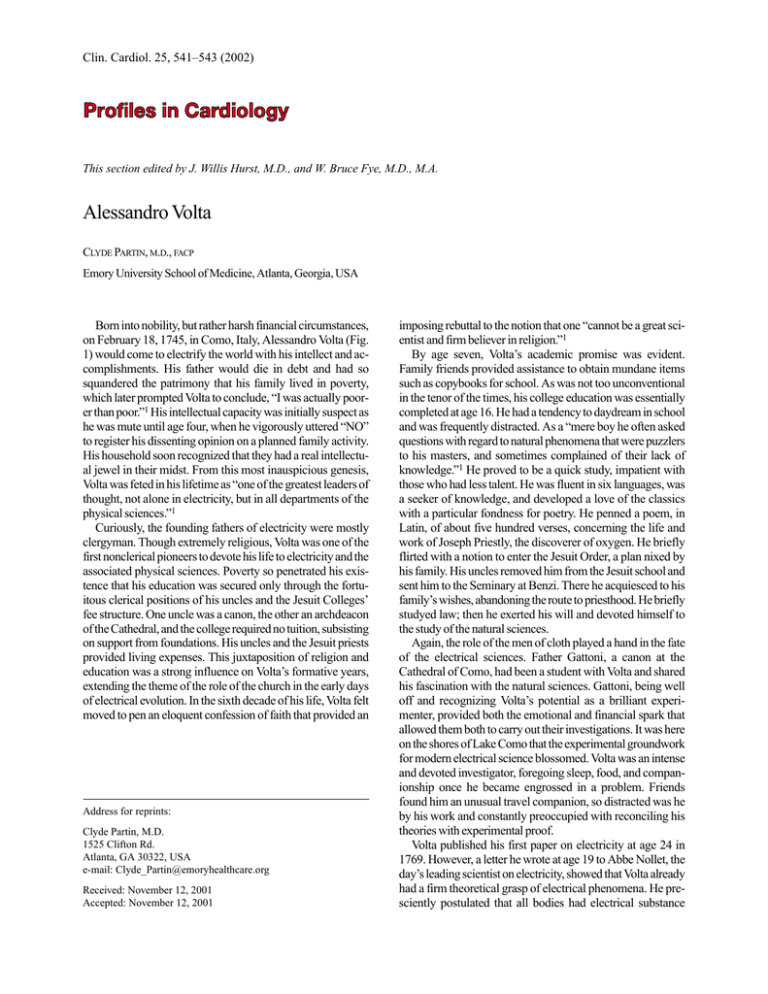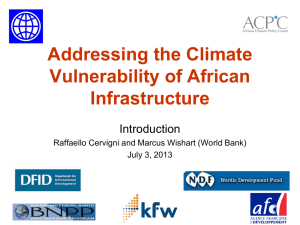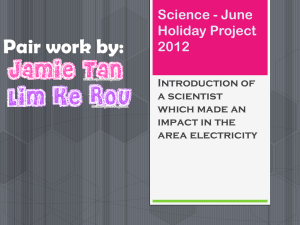Alessandro Volta - Wiley Online Library
advertisement

Clin. Cardiol. 25, 541–543 (2002) This section edited by J. Willis Hurst, M.D., and W. Bruce Fye, M.D., M.A. Alessandro Volta CLYDE PARTIN, M.D., FACP Emory University School of Medicine, Atlanta, Georgia, USA Born into nobility, but rather harsh financial circumstances, on February 18, 1745, in Como, Italy, Alessandro Volta (Fig. 1) would come to electrify the world with his intellect and accomplishments. His father would die in debt and had so squandered the patrimony that his family lived in poverty, which later prompted Volta to conclude, “I was actually poorer than poor.”1 His intellectual capacity was initially suspect as he was mute until age four, when he vigorously uttered “NO” to register his dissenting opinion on a planned family activity. His household soon recognized that they had a real intellectual jewel in their midst. From this most inauspicious genesis, Volta was feted in his lifetime as “one of the greatest leaders of thought, not alone in electricity, but in all departments of the physical sciences.”1 Curiously, the founding fathers of electricity were mostly clergyman. Though extremely religious, Volta was one of the first nonclerical pioneers to devote his life to electricity and the associated physical sciences. Poverty so penetrated his existence that his education was secured only through the fortuitous clerical positions of his uncles and the Jesuit Colleges’ fee structure. One uncle was a canon, the other an archdeacon of the Cathedral, and the college required no tuition, subsisting on support from foundations. His uncles and the Jesuit priests provided living expenses. This juxtaposition of religion and education was a strong influence on Volta’s formative years, extending the theme of the role of the church in the early days of electrical evolution. In the sixth decade of his life, Volta felt moved to pen an eloquent confession of faith that provided an Address for reprints: Clyde Partin, M.D. 1525 Clifton Rd. Atlanta, GA 30322, USA e-mail: Clyde_Partin@emoryhealthcare.org Received: November 12, 2001 Accepted: November 12, 2001 imposing rebuttal to the notion that one “cannot be a great scientist and firm believer in religion.”1 By age seven, Volta’s academic promise was evident. Family friends provided assistance to obtain mundane items such as copybooks for school. As was not too unconventional in the tenor of the times, his college education was essentially completed at age 16. He had a tendency to daydream in school and was frequently distracted. As a “mere boy he often asked questions with regard to natural phenomena that were puzzlers to his masters, and sometimes complained of their lack of knowledge.”1 He proved to be a quick study, impatient with those who had less talent. He was fluent in six languages, was a seeker of knowledge, and developed a love of the classics with a particular fondness for poetry. He penned a poem, in Latin, of about five hundred verses, concerning the life and work of Joseph Priestly, the discoverer of oxygen. He briefly flirted with a notion to enter the Jesuit Order, a plan nixed by his family. His uncles removed him from the Jesuit school and sent him to the Seminary at Benzi. There he acquiesced to his family’s wishes, abandoning the route to priesthood. He briefly studyed law; then he exerted his will and devoted himself to the study of the natural sciences. Again, the role of the men of cloth played a hand in the fate of the electrical sciences. Father Gattoni, a canon at the Cathedral of Como, had been a student with Volta and shared his fascination with the natural sciences. Gattoni, being well off and recognizing Volta’s potential as a brilliant experimenter, provided both the emotional and financial spark that allowed them both to carry out their investigations. It was here on the shores of Lake Como that the experimental groundwork for modern electrical science blossomed. Volta was an intense and devoted investigator, foregoing sleep, food, and companionship once he became engrossed in a problem. Friends found him an unusual travel companion, so distracted was he by his work and constantly preoccupied with reconciling his theories with experimental proof. Volta published his first paper on electricity at age 24 in 1769. However, a letter he wrote at age 19 to Abbe Nollet, the day’s leading scientist on electricity, showed that Volta already had a firm theoretical grasp of electrical phenomena. He presciently postulated that all bodies had electrical substance 542 Clin. Cardiol. Vol. 25, November 2002 FIG. 1 Alessandro Volta (1745–1827). Source: Dibner B: Ten Founding Fathers of the Electrical Science. Burndy Corporation, Norwalk, Conn. 1954. within them in a state of equilibrium. A perturbation of this equanimity, representing some interaction between a proposed electrical essence and matter, led to an electrical event. Working steadily, by 1775 he announced the development of the electrophorus. Prior to the electrophorus, students of electricity were hindered by the ephemeral existence of the subject under scrutiny, garnering their data on the basis of fleeting static discharges. The electrophorus acted as a reservoir, providing a more lasting source of subject matter. Of an exceedingly careful nature, Volta wrote to Joseph Priestly before announcing his invention. Joseph Priestly, known to most as the father of modern chemistry, was the author of a respected work on the complete history of electricity. Volta wished to know if his machine was “novel in the domain of electrical advance.”1 A steady current of useful inventions followed, including the condensing electroscope, which allowed the measurement of minute amounts of electricity; the electrical pistol, which assisted in the study of inflammable gases; the eudiometer, a contraption for measuring oxygen levels. Besides the practical benefits accrued from these innovations, they elevated the status of university physics departments to a more respectable realm. In light of these successes, Volta began his academic career at the College of Como in 1774, serving as professor of experimental physics. In 1779, he began a 40-year career at the University of Pavia, where he initially concentrated on the study of gases. Some of his observations were instrumental in the establishment of Charles’ law. In 1786, Volta sojourned throughout Europe, discoursing with the great minds of science. His humanistic and practical side again surfaced as he noted the great dependence the rest of Europe had developed on the potato. Recognizing its food value, he introduced the potato to Italy, which is just “one of the reasons Italians have always looked up to him as a benefactor of his native land.”1 In 1791, Volta received a copy of a paper from Luigi Galvani, a professor of anatomy at the University of Bologna. Galvani had serendipitously noted the muscles of some dissected frog legs he was studying contracted when a nearby electrostatic generator unexpectedly discharged. He and his assistants also observed that the touch of a scalpel produced a similar result. Galvani’s explanation for the muscular movement was an ethereal and miasmic substance he called “animal electricity,” a school of thought that became known as Galvanism. Volta, intrigued by Galvani’s work but not one to jump to conclusions, instituted his own series of experiments. In a series of ingenious studies, Volta’s “incredulity” changed to doubt. Maintaining his “methodological rule of keeping strictly to the facts, without transcending them in bold theoretical constructs. [sic] This led him to adopt very severe and prudent criteria for selecting hypothesis and explanations.”2 Volta concluded that the “muscle twitchings were not due to the presence of animal electricity, but due to the fact that the metals touching the different portions of the moist nerve muscle preparation really set up minute currents of ordinary electricity.”1 While reams would come to be written about the competing theories of Galvani and Volta, suffice it to say that Volta’s demonstrations showed how “thoroughly empirical were his methods and how modern his scientific spirit,” conclusively refuting Galvanism. Volta’s studies not only laid the groundwork for electrochemistry but also led him to develop the Voltaic pile—so called because of the way he stacked metal discs on top of each other—better known today as the battery. This invention, announced in 1800, garnered him world acclaim. The French Academy of Sciences invited him to Paris to demonstrate his findings. Napoleon was a patron of the sciences and, in astute recognition of the practical aspects of Volta’s work, awarded him 6,000 lire and an annual stipend of 3,000 lire. Shocked by Napoleon’s gift, Volta would not accept the money until the decree was approved by the Pope. Fame and numerous honors followed. At the International Electrical Congress in Paris in 1881, the term “volt” was advanced as a measure of electrical force, thus formally and eponymically enshrining Volta into perpetuity. When he was approaching age 50, Volta married the youngest of six daughters of Count Ludovico Peregrini. It was a marriage of great intimacy and charm, marred only by the death of the eldest son, Flaminio in 1814. Volta lived a simple and unpretentious life, dedicated to the church and revered by loyal servants and his neighbors for his humanitarian and endearing demeanor. He became known in the community as “Il mago benefico” (the beneficent magician), a reflection of the love and respect the townspeople had for him. Fortunately, “after the Galvani-Volta debates had ended the life sciences would no longer be driven by the animalspirits paradigm of the past.”3 Recent reflections on Galvani C. Partin: Allessandro Volta and Volta’s careers have pointed out several misconceptions and even claimed both were right.4–6 Galvani deserves more credit for his original groundwork in electrophysiology, even if it was Volta who more correctly elucidated Galvani’s findings. Furthermore, Volta should be looked upon not as a mere physicist, but as a multifaceted scientist whose work had great relevance for electrochemistry and the physiology of neuroscience. Neither did any work in cardiac electrophysiology, but others, building on the accomplishments of Volta and Galvani, would usher in the age of electrocardiography. We would do well to remember the words of Arago, who in his eulogy of Volta, who died at the age of 82, proclaimed the electric battery as “the most marvelous instrument created by the mind of man, not excluding even the telescope or steam engine.”7 543 References 1. 2. 3. 4. 5. 6. 7. Potamian B, Walsh JJ: Makers of Electricity. New York: Fordham University Press, 1909 Pera M: The Ambiguous Frog: The Galvani-Volta Controversy on Animal Electricity. Translated by Jonathon Mandelbaum. Princeton, N.J.: Princeton University Press, 1992 Finger S: Minds Behind the Brain: A History of the Pioneers and Their Discoveries. New York: Oxford University Press, 2000 Piccolino M: Luigi Galvani and animal electricity: Two centuries after the foundation of electrophysiology. Trends Neurosci 1997;20 (10):443–448 Piccolino M: The bicentennial of the Voltaic battery (1800–2000): The artificial electric organ. Trends Neurosci 2000;23(4):147–151 Hellman H: Great Feuds in Medicine. New York: John Wiley & Sons, Inc., 2001 Dibner B: Ten Founding Fathers of the Electrical Science. Norwalk, Conn: Burndy Corporation, 1954 Clin. Cardiol. 25, 543 (2002) : Spontaneous Coronary Artery Dissection ARMAGAN ALTUN, M.D., OKAN ERDOGAN, M.D. Department of Cardiology, School of Medicine, Trakya University, Edirne, Turkey A 73-year-old woman presented to our clinic with stable angina pectoris. On coronary angiography, the left anterior descending coronary artery showed critical stenosis in the proximal region and a type B spontaneous dissection line extending from the stenosis to the left main coronary artery (Fig. 1). Spontaneous coronary artery dissection is an extremely rare cause of myocardial ischemia associated with significantly high morbidity and mortality. It is usually observed in relatively young female patients and during pregnancy. Reference Elming H, Kober L: Spontaneous coronary artery dissection: Case report and literature review. Scand Cardiovasc J 1999;33:175–179 FIG.1 Coronary angiogram revealed spontaneous coronary artery dissection in the proximal left anterior descending artery portion extending to left main artery (arrows).




